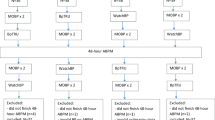Abstract
Objective. To evaluate the performance and to define limitations of a noninvasive blood pressure monitoring device in the critically ill pediatric population. Method. Patients were included in the study if they were admitted to the Pediatric Intensive Care Unit, were between the ages of 1 month and 18 years with wrist circumferences of ≥ 10 cm, and had an indwelling arterial line. Patients were excluded if their systolic blood pressure differed by ≥ 7.5% between their upper extremities. The measurements were collected simultaneously with those from an arterial line by a computer interfaced with the noninvasive blood pressure monitoring system and the patient’s monitor. Heart rates were calculated from the recorded pulse waveforms of the arterial lines. Comparison analyses were performed via bias and precision plots of the blood pressure and heart rate data in addition to calculation of Pearson’s correlation coefficients and concordance correlation coefficients. As a nonparametric method of comparison, the proportion of measurements that differed by greater than 10% was calculated. Results. Blood pressures and heart rates of 20 patients between the ages of 12 months and 17 years were monitored by a noninvasive blood pressure monitor for 30 min per patient. This data collection resulted in 2015 data points for each blood pressure and heart rate for comparison of methods. Concordance correlation coefficients were the following: systolic blood pressure, 0.93; diastolic blood pressure, 0.93; mean blood pressure, 0.94; and heart rate, 0.85. Conclusions. The noninvasive blood pressure monitor is capable of producing an accurate blood pressure measurement every 12–15 heartbeats in addition to providing a pulse waveform and digital display of the heart rate. Our study showed good agreement between the methods in the normotensive and hypertensive critically ill pediatric population with a wrist circumference limitation defined at ≥ 11 cm.
Similar content being viewed by others
References
O’Brien E, Atkins N, Mee F, O’Malley K, Evaluation of blood pressure measuring devices. Clin Exp Hypertens 1993; 15(6): 1087–1097.
Steinhart CM, Arterial catheterization. In: Dieckmann RA, Fiser DH, Selbst SM, eds. Illustrated textbook of pediatric emergency and critical care procedures. St. Louis: Mosby-Year Book, 1997: 213–219.
Belani K, Ozaki M, Hynson J, Hartmann T, Reyford H, Martino J, Poliac M, Miller R, A new noninvasive method to measure blood pressure. Anesthesiology 1999; 91(3): 686–692.
Simpson PM, Phillips PR, Lensing S, Hamer R, Reliably assessing reliability with SAS software. Proceedings of the 23rd Annual SAS Users Group International Conference, Cary, NC, 1998.
Bland JM, Altman DG, Measuring agreement in method comparison studies. Stat Methods Med Res 1999; 8: 135-160.
Iyriboz Y, Hearon CM, A proposal for scientific validation of instruments for indirect blood pressure measurement at rest, during exercise, and in critical care. J Clin Monit 1994; 10(3): 163-177.
Gorny DA, Arterial blood pressure measurement technique. AACN Clin Issues Crit Care Nurs 1993; 4(1): 66–80.
Bridges MEJ, Middleton R, Direct arterial vs oscillometric monitoring of blood pressure: Stop comparing and pick one (a decision-making algorithm). Critical Care Nurse 1997; 17(3): 58–72.
Ng KG, Small CF, Survey of automated noninvasive blood pressure monitors. J Clin Eng 1994; 19(6): 452–475.
Heulitt MJ, Farrington EA, O’Shea TM, Stoltzman SM, Srubar NB, Levin DL, Double-blind, randomized, controlled trial of papaverine-containing infusions to prevent failure of arterial catheters in pediatric patients. Crit Care Med 1993; 21(6): 825–829.
Prisant LM, Alpert BS, Robbins CB, Berson AS, Hayes M, Cohen ML, Sheps SG, American national standard for nonautomated sphygmomanometers. Summary report. Am J Hypertens 1995; 8: 210–213.
Elmquist L, Noninvasive automatic blood pressure machines in the PACU—is there a price? J Clin Monit 1994; 10(2): 134–136.
O’Brien E, Petrie J, Littler W, de Swiet M, Padfield PL, Altman DG, Bland M, Coats A, Atkins N, Short report: An outline of the revised British Hypertension Society protocol for the evaluation of blood pressure measuring devices. J Hypertens 1993; 11: 677–679.
Goonasekera CD, Wade AM, Slattery M, Brennan E, Dillon MJ, Validation of new blood pressure monitors for children: Defects by default. Eur J Pediatr 1998; 157(12): 1035–1036.
Author information
Authors and Affiliations
Corresponding author
Additional information
Wankum PC, Thurman TL, Holt SJ, Hall RA, Simpson PM, Heulitt MJ. Validation of a noninvasive blood pressure monitoring device in normotensive and hypertensive pediatric intensive care patients.
Rights and permissions
About this article
Cite this article
Wankum, P.C., Thurman, T.L., Holt, S.J. et al. Validation of a noninvasive blood pressure monitoring device in normotensive and hypertensive pediatric intensive care patients. J Clin Monit Comput 18, 253–263 (2004). https://doi.org/10.1007/s10877-005-1421-3
Received:
Revised:
Issue Date:
DOI: https://doi.org/10.1007/s10877-005-1421-3




